How to clean an airbrush?
How to clean an airbrush?
Whether it is a suction or gravity airbrush, single action or double action, and whatever the brand, it is advisable to clean your airbrush well immediately after use to prevent it from becoming clogged, completely or partially, and therefore to maintain perfect jet and spray quality.
For beginners in the difficult practice of airbrushing, we will notice that the phase of disassembly, cleaning, problem finding, reassembly, jet adjustment, occupies at least 80% of the time spent “doing airbrushing”: let them rest assured, it’s normal! Learning to disassemble and clean the airbrush is essential.
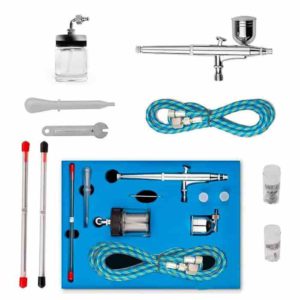
Cleaning is done manually with thinner, and tools (brushes, tips, compressed air). It can be done (when the paint is dry) with an ultrasonic cleaner.
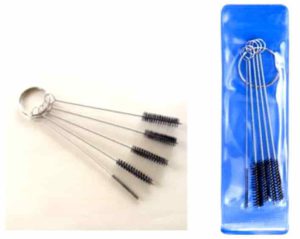
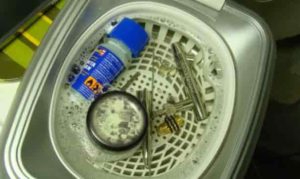
When to clean your airbrush?
– between each color: when changing color, simply empty the remaining paint and fill with cleaning thinner to purge the airbrush once or twice.
The purge is carried out either in a specially designed pot, or in the mini extraction cabin while it is running.
Purging is carried out either in a specially designed pot or in the mini extraction cabin while it is running.
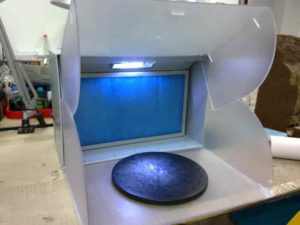
– when the jet has a defect, the flow is jerky, bubbles form in the cup, or the jet goes sideways…
Basically whenever something goes wrong. Especially when doing precision work!
First, a quick check of the assembly and tightening of the airbrush parts, as well as their condition, will be carried out, then a complete purge will be carried out with a dose of thinner. If the anomaly is not resolved, then the airbrush will be completely disassembled, to quickly clean it with thinner. After reassembly, a good jet quality should be found.
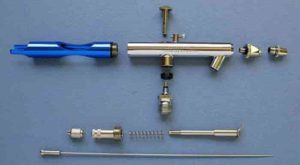
-after use: normally with a purge repeated several times, without disassembly, you will find your airbrush in good working order the next day. If possible leave some thinner in the cup and in the airbrush.
Note: after using a two-component paint or varnish with hardener, it is very important to double the rinsing and brushing of all parts in contact with the product.
Deep cleaning
– regularly, after about twenty hours of use, it is necessary to carry out a deep cleaning, to remove the dried paint residues, with the most complete disassembly possible, and a soaking in a solvent thinner (or in the ultrasonic cleaner, for the best equipped airbrushers). Only the metal parts are put to stripping in the solvent pot, in a small strainer, so as not to lose the smallest parts, from 1h to 24h depending on the dirt. Plastic or rubber parts will not be soaked for more than 5 min.
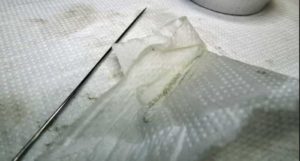
This regular stripping is also valid in the case of using water-based paints or solvent-based paints.
Once the parts are soaked and the paint is well softened, we immediately proceed to brushing (with a brush rod or a toothbrush).
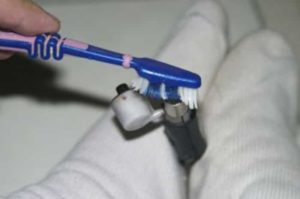
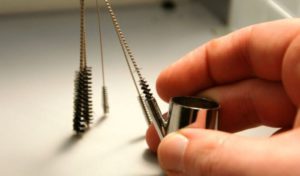
To clean the nozzle, use only compressed air, or a needle, with great care. Never use a scalpel, or force the nozzle.
You can also blow with compressed air to dislodge dirt in difficult places. Finally, re-dip the parts in a clean, clear thinner, and wipe the parts with a clean paper.
What should you use to clean your airbrush?
The solvent pot, for soaking parts, contains a universal liquid cleaning diluent of the bodywork type. Never acetone (too strong), no white spirit, or alcohol (too mild). The diluent in the pot can be used for a long time without being changed.
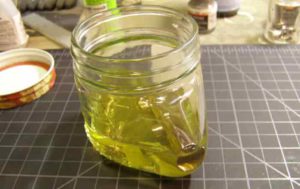
A distinction is made between a thinner to reduce the viscosity of paints and varnishes, and a cleaning thinner (less fine in quality and more aggressive)
We also differentiate between thinners for water-based paints and varnishes (example: Vallejo paints), and solvent-based thinners and varnishes (example: Graphic paints)
You absolutely cannot reduce or clean water-based paints with solvent-based thinners, and vice versa, otherwise you risk making mayonnaise!
However, it should be noted that only solvents can be effective on dried paints, whether they are water-based or solvent-based.
Find out how to clean your aeroplane using ultrasound
The least laborious and most effective way to remove paint residue from every nook and cranny.
Here is a selection of 2 ultrasonic cleaners and the details of how they work : Ultrasonic Cleaners Model GT F1 and SONIC D2
How to airbrush?
How to use an airbrush for modeling?
How to draw with an airbrush on canvas?
How to use an airbrush for body painting?
How to draw and paint with an airbrush on a body?
How to paint with an airbrush game figures and miniatures?
